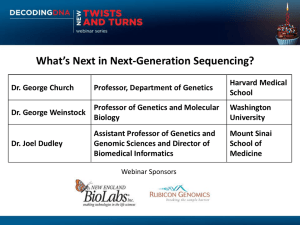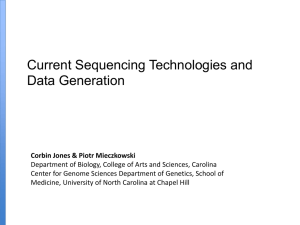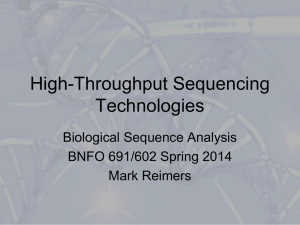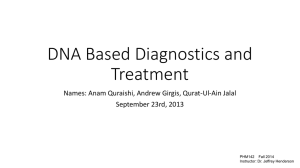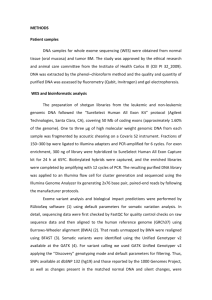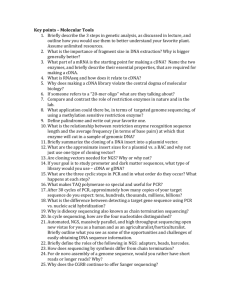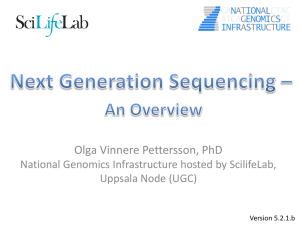Sequencer
advertisement
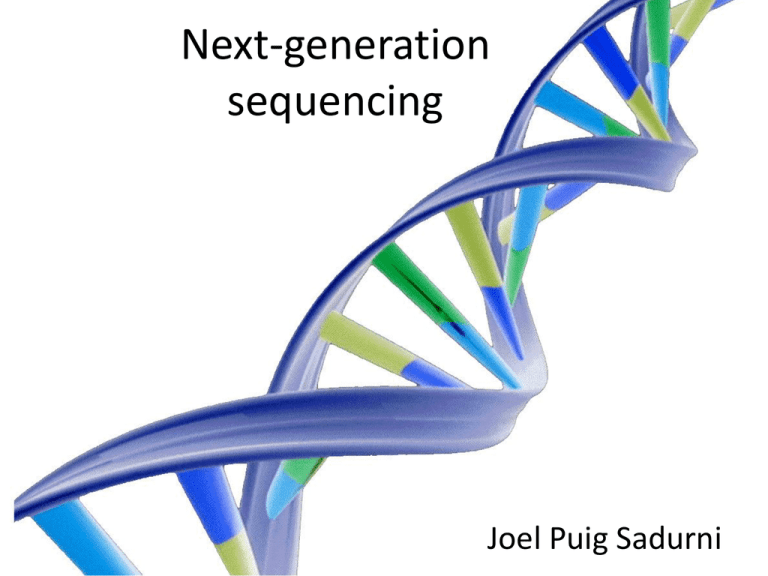
Next-generation sequencing Joel Puig Sadurni Introduction • Whole genome sequences of tens of species and individuals. • Gene expression profiling in multiple conditions, tissues, individuals and species • Mapping of functional regions in the genome • The advent of next generation sequencing technologies has opened new possibilities in the analysis of human disease. SANGER • Sanger sequencing has been the universally used sequencing technology since its publication in 1977. • One of the strengths of Sanger sequencing is the very low error rate, and is still considered the gold standard for nucleic acid sequencing. New mutations identified by NGS technologies are validated using Sanger sequencing Second generation technologies • • Second generation technologies, also called high-throughput or NGS technologies, have exponentially increased the quantity of sequences generated, producing up to several million bases (Gb) in a single run the main concept behind them is similar (library preparation) Third generation sequencing technologies • The race for the 1000$ genome in 1 day • The main current limitation is the higher error rate. • PacBio RS (Pacific Biosciences) • GridION (Oxford Nanopore Technologies) • Ion Torrent ( Life Technologies Corporation) PacBio RS (Pacific Biosciences) Single molecule, real-time(SMRTTM) detection provides direct measurement of individual molecules • Templates can be prepared for the PacBio RS without PCR amplification, resulting in more uniform sequence coverage across genomic regions regardless of GC content, facilitating the detection of minor variants in heterogeneous samples • While observing single molecule sequencing by a highly processive strand-displacing DNA polymerase in real time, the system also records the kinetics of each nucleotide incorporation reaction, identifying base modifications of the native templates, such as DNA methylation GridION (Oxford Nanopore Technologies) GridION (Oxford Nanopore Technologies) If you can put 20 of the GridIONs together you can sequence the entire human genome in 15 minutes for about $1500 per genome. A lot of the interest has come from the (very cool) MinION, miniaturized version of the GridION, disposable USB-key sequencer that can sequence about a billion base pairs of DNA, and cost around $500-$900 each. Ion Torrent ( Life Technologies Corporation) Ion Torrent ( Life Technologies Corporation) An integrated semiconductor device enabling non-optical genome sequencing. Rothberg JM et al. Nat Methods. 2011;8(9):708-9. PMID: 21985001 Ion Torrent ( Life Technologies Corporation) Ion Torrent ( Life Technologies Corporation) • The Personal Genome Machine (PGM™) Sequencer: – – – – 55.000 € Sequencing Scale:3 Mb to 1 Gb Read Length: 35 - 200 bases (average: 100 bases) Run Time: 2 hrs (average) • Ion Proton™ Sequencer – 117.000 € – Throughput: Up to 10 Gb (Note: The Ion Proton™ II Chip will be available about six months after the Ion Proton™ I Chip. The Ion Proton™ II Chip will enable sample-to-variant analysis of a human genome in a single day, at up to 20x coverage.) – Read length:Up to 200-base fragment reads – Sequencing run time: As little as 2 hours for 100-base reads Aplications • • • • • • • • • • • • • • • • • Targeted Resequencing De Novo Assembly Pathogen Identification Transcript Analysis Genetic human variation : SNP, CNV Comparative studies Epigenomics Identification of all mutations in an organism Chip-seq: interactions protein-DNA Ancient DNA DNA mixtures from diverse ecosystems, metagenomics Resequencing previously published reference strains Errors in published literature Expand the number of available genomes Sequencing extremely large genomes Detection of cancer specific alleles avoiding traditional cloning Detecting ncRNA Bibliography • An integrated semiconductor device enabling non-optical genome sequencing. Rothberg JM et al. Nat Methods. 2011;8(9):708-9. • Next-generation sequencing technologies for environmental DNA research. Shokralla S. et al. Molecular Ecology (2012) 21, • Performance comparison of benchtop high-throughput sequencing platforms. Loman N. et al. Nature biotechnology (2012) V.30 number 6 • http://www.pacificbiosciences.com • http://www.iontorrent.com/ • http://www.nanoporetech.com



